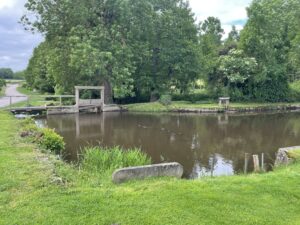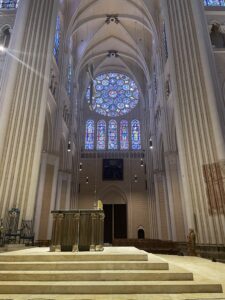In which Sid and Doris follow in the footsteps of Lord Clark of Civilisation to Chartres.
In 1969 art historian Kenneth Clark wrote and presented BBC’s documentary series Civilisation (shot on real film). In the second episode, to introduce gothic architecture in Medieval Europe, he stood in front of the west door at Chartres cathedral.
There were very few takes, film was expensive and of course they couldn’t see what they had. It is an arresting talk with no computer graphics, flashy edits or drone shots. It would not be made now because attention spans are deemed shorter. Sid saw it first time round and now knows one of the production assistants of the period. Do look it up, you can come back later.
Happily, Chartres is the next stop. It is not actually raining and the going is good and flat.
 At Chennebrun we stop by this water feature, part of the Fosses (ditches, moats) du Roy Henri 2. He decided to dig a moat to separate Normandy from the Kingdom of France ‘to repulse the brigands and keep pillaging barons at bay’ Sid loosely translates.
At Chennebrun we stop by this water feature, part of the Fosses (ditches, moats) du Roy Henri 2. He decided to dig a moat to separate Normandy from the Kingdom of France ‘to repulse the brigands and keep pillaging barons at bay’ Sid loosely translates.
The monks do not record if he did any digging himself. Started in 1150ish and finished in 1168 this is one of the bits left though most of it is traced on the info board.
 At Senonches it is market day to make a buzzing little town, which is a great contrast to many small towns traversed. Though it is only 11.45 we stop for galette lunch having a good idea of what else is out there if we postpone.
At Senonches it is market day to make a buzzing little town, which is a great contrast to many small towns traversed. Though it is only 11.45 we stop for galette lunch having a good idea of what else is out there if we postpone.
It is a couple of hours flat, chilly riding into Chartres and the ‘rooms over a restaurant bar’ style hotel right by the cathedral. The room has a circular bed and not entirely successful eccentric decoration. It is raining, so a good thing that the restaurants are on the cathedral square.
But first, we are in plenty of time to heed Lord Clark and visit. The French state owns the cathedrals and has had a major renovation underway since 2007, partly paid for by American Friends of Chartres who seem to look after the glass. (In Salisbury the big renovation project started in 1983 and the scaffolding has just come down.)
 A surprising finding of the architectural historians was that the stone was thickly covered in what car painters would recognise as fill/prime to hide the rough masonry.
A surprising finding of the architectural historians was that the stone was thickly covered in what car painters would recognise as fill/prime to hide the rough masonry.
When Sid first followed Lord Clark in about 1971 the interior was dark with the candle soot of centuries. It now looks quite bright, perhaps as it did when new. It will be interesting to see how Notre Dame de Paris is remade after the fire.
Doris, as chief cathedral adviser, will tell you more about what we saw and show you the carvings after their cleaning.